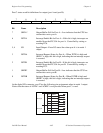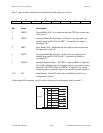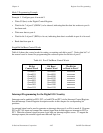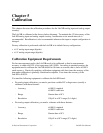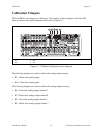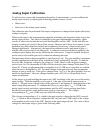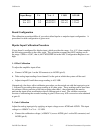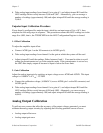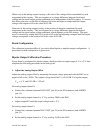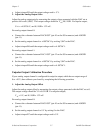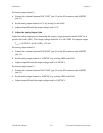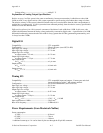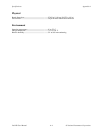Chapter 5 Calibration
© National Instruments Corporation 5-5 Lab-NB User Manual
b. Take analog input readings from channel 0 at a gain of 1, and adjust trimpot R10 until the
ADC readings flicker evenly between 2,046 and 2,047. Alternatively, you can average a
number of readings (approximately 100) and adjust trimpot R10 until the average reading is
2,046.5.
Unipolar Input Calibration Procedure
If your board is configured for unipolar input, which has an input range of 0 to +10 V, then
complete the following steps in sequence. This procedure assumes that ADC readings are in the
range 0 to 4,095, that is, the TWOSCMP bit in the ADC Configuration Register is cleared.
1. Offset Calibration
To adjust the amplifier input offset:
a. Connect ACH0 (pin 1 on the I/O connector) to AGND (pin 9).
b. Take analog input readings from channel 0 at the gain at which the system will be used.
c. Adjust trimpot R1 until the readings flicker between 0 and 1. Care must be taken to avoid
setting the potentiometer too low in the unipolar mode. If the potentiometer is set too low,
the ADC then simply outputs 0 because its input is below the lower limit.
2. Gain Calibration
Adjust the analog input gain by applying an input voltage across ACH0 and AGND. This input
voltage is +9.99634 V or V
+fs
- 1.5 LSB.
a. Connect the calibration voltage (+9.99634 V) across ACH0 (pin 1 on the I/O connector) and
AGND (pin 0).
b. Take analog input readings from channel 0 at a gain of 1, and adjust trimpot R10 until the
ADC readings flicker evenly between 4,094 and 4,095. Alternately, you can average a
number of readings (approximately 100) and adjust trimpot R10 until the average reading is
4,094.5.
Analog Output Calibration
To null out error sources that affect the accuracy of the output voltages generated, you must
calibrate the analog output circuitry by adjusting the following potential sources of error:
• Analog output offset error
• Analog output gain error



